Identification of Potential Inhibitors of MurD Enzyme of Staphylococcus aureus from a Marine Natural Product Library
Abstract
1. Introduction
2. Materials and Methods
2.1. Homology Modelling and Protein Preparation
2.2. Reactive Pocket Preparation and Ligand Treatment
2.3. Receptor-Based Virtual Screening
2.4. Shape Screening
2.5. ADMET Analysis
2.6. Molecular Dynamics
3. Results
3.1. Homology Modeling and Validation
3.2. Docking Analysis
3.3. Shape Screening
3.4. ADME Drug Potency Analysis
3.5. Molecular Dynamics
4. Discussion
5. Conclusions
Author Contributions
Funding
Institutional Review Board Statement
Informed Consent Statement
Data Availability Statement
Conflicts of Interest
Sample Availability
References
- Guo, Y.; Song, G.; Sun, M.; Wang, J.; Wang, Y. Prevalence and Therapies of Antibiotic-Resistance in Staphylococcus aureus. Front. Cell. Infect. Microbiol. 2020, 10, 107. [Google Scholar] [CrossRef] [PubMed]
- Paling, F.P.; Hazard, D.; Bonten, M.J.M.; Goossens, H.; Jafri, H.S.; Malhotra-Kumar, S.; Sifakis, F.; Weber, S.; Kluytmans, J.A.J.W. Association of Staphylococcus aureus Colonization and Pneumonia in the Intensive Care Unit. JAMA Netw. Open 2020, 3, e2012741. [Google Scholar] [CrossRef]
- El Zoeiby, A.; Sanschagrin, F.; Levesque, R.C. Structure and function of the Mur enzymes: Development of novel inhibitors. Mol. Microbiol. 2002, 47, 1–12. [Google Scholar] [CrossRef] [PubMed]
- Bertrand, J.A. Crystal structure of UDP-N-acetylmuramoyl-l-alanine:d-glutamate ligase from Escherichia coli. EMBO J. 1997, 16, 3416–3425. [Google Scholar] [CrossRef]
- Perdih, A.; Kotnik, M.; Hodoscek, M.; Solmajer, T. Targeted molecular dynamics simulation studies of binding and conformational changes in E. coli MurD. Proteins Struct. Funct. Bioinform. 2007, 68, 243–254. [Google Scholar] [CrossRef] [PubMed]
- Schindler, B.D.; Jacinto, P.; Kaatz, G.W. Inhibition of drug efflux pumps in Staphylococcus aureus: Current status of potentiating existing antibiotics. Future Microbiol. 2013, 8, 491–507. [Google Scholar] [CrossRef]
- Sova, M.; Kovač, A.; Turk, S.; Hrast, M.; Blanot, D.; Gobec, S. Phosphorylated hydroxyethylamines as novel inhibitors of the bacterial cell wall biosynthesis enzymes MurC to MurF. Bioorganic Chem. 2009, 37, 217–222. [Google Scholar] [CrossRef] [PubMed]
- Pratviel-Sosa, F.; Acher, F.; Trigalo, F.O.; Blanot, D.; Azerad, R.; Heijenoort, J. Effect of various analogues of D-glutamic acid on the D-glutamate-adding enzyme from Escherichis coli. FEMS Microbiol. Lett. 1994, 115, 223–228. [Google Scholar] [CrossRef]
- Kotnik, M.; Humljan, J.; Contreras-Martel, C.; Oblak, M.; Kristan, K.; Hervé, M.; Blanot, D.; Urleb, U.; Gobec, S.; Dessen, A.; et al. Structural and Functional Characterization of Enantiomeric Glutamic Acid Derivatives as Potential Transition State Analogue Inhibitors of MurD Ligase. J. Mol. Biol. 2007, 370, 107–115. [Google Scholar] [CrossRef] [PubMed]
- Humljan, J.; Kotnik, M.; Contreras-Martel, C.; Blanot, D.; Urleb, U.; Dessen, A.; Šolmajer, T.; Gobec, S. Novel Naphthalene-N-sulfonyl-d-glutamic Acid Derivatives as Inhibitors of MurD, a Key Peptidoglycan Biosynthesis Enzyme. J. Med. Chem. 2008, 51, 7486–7494. [Google Scholar] [CrossRef] [PubMed]
- Štrancar, K.; Blanot, D.; Gobec, S. Design, synthesis and structure–activity relationships of new phosphinate inhibitors of MurD. Bioorganic Med. Chem. Lett. 2006, 16, 343–348. [Google Scholar] [CrossRef] [PubMed]
- Bhadury, P.; Mohammad, B.T.; Wright, P.C. The current status of natural products from marine fungi and their potential as anti-infective agents. J. Ind. Microbiol. Biotechnol. 2006, 33, 325–337. [Google Scholar] [CrossRef] [PubMed]
- Arockianathan, P.M.; Mishra, M.; Niranjan, R. Recent Status and Advancements in the Development of Antifungal Agents: Highlights on Plant and Marine Based Antifungals. Curr. Top. Med. Chem. 2019, 19, 812–830. [Google Scholar] [CrossRef]
- Bhatnagar, I.; Kim, S.-K. Marine Antitumor Drugs: Status, Shortfalls and Strategies. Mar. Drugs 2010, 8, 2702–2720. [Google Scholar] [CrossRef] [PubMed]
- Sharma, P.; Kumar, M.; Dahiya, S.; Sood, S.; Das, B.K.; Kaur, P.; Kapil, A. Structure based drug discovery and in vitro activity testing for DNA gyrase inhibitors of Salmonella enterica serovar Typhi. Bioorganic Chem. 2020, 104, 104244. [Google Scholar] [CrossRef] [PubMed]
- Azam, M.A.; Jupudi, S.; Saha, N.; Paul, R.K. Combining molecular docking and molecular dynamics studies for modelling Staphylococcus aureus MurD inhibitory activity. SAR QSAR Environ. Res. 2018, 30, 1–20. [Google Scholar] [CrossRef] [PubMed]
- Halgren, T. New Method for Fast and Accurate Binding-site Identification and Analysis. Chem. Biol. Drug Des. 2007, 69, 146–148. [Google Scholar] [CrossRef] [PubMed]
- Ramachandran, B.; Kesavan, S.; Rajkumar, T. Molecular modeling and docking of small molecule inhibitors against NEK2. Bioinformation 2016, 12, 62–68. [Google Scholar] [CrossRef] [PubMed]
- Huang, H.; Zhang, G.; Zhou, Y.; Lin, C.; Chen, S.; Lin, Y.; Mai, S.; Huang, Z. Reverse Screening Methods to Search for the Protein Targets of Chemopreventive Compounds. Front. Chem. 2018, 6, 138. [Google Scholar] [CrossRef]
- Wang, Z.; Lu, Y.; Seibel, W.; Miller, D.D.; Li, W. Identifying Novel Molecular Structures for Advanced Melanoma by Ligand-Based Virtual Screening. J. Chem. Inf. Model. 2009, 49, 1420–1427. [Google Scholar] [CrossRef] [PubMed][Green Version]
- Kagami, L.; Roca-Martínez, J.; Gavaldá-García, J.; Ramasamy, P.; Feenstra, K.A.; Vranken, W.F. Online biophysical predictions for SARS-CoV-2 proteins. BMC Mol. Cell Biol. 2021, 22, 1–7. [Google Scholar] [CrossRef]
- Hosseini, F.S.; Amanlou, M. Anti-HCV and anti-malaria agent, potential candidates to repurpose for coronavirus infection: Virtual screening, molecular docking, and molecular dynamics simulation study. Life Sci. 2020, 258, 118205. [Google Scholar] [CrossRef]
- Van Der Spoel, D.; Lindahl, E.; Hess, B.; Groenhof, G.; Mark, A.E.; Berendsen, H.J.C. GROMACS: Fast, flexible, and free. J. Comput. Chem. 2005, 26, 1701–1718. [Google Scholar] [CrossRef]
- Nava, M. Implementing dimer metadynamics using gromacs. J. Comput. Chem. 2018, 39, 2126–2132. [Google Scholar] [CrossRef]
- Wiederstein, M.; Sippl, M.J. ProSA-web: Interactive web service for the recognition of errors in three-dimensional structures of proteins. Nucleic Acids Res. 2007, 35, W407–W410. [Google Scholar] [CrossRef] [PubMed]
- Rahman, M.S.; Hossain, M.S.; Saha, S.K.; Rahman, S.; Sonne, C.; Kim, K.-H. Homology Modeling and Probable Active Site Cavity Prediction of Uncharacterized Arsenate Reductase in Bacterial spp. Appl. Biochem. Biotechnol. 2020, 193, 1–18. [Google Scholar] [CrossRef] [PubMed]
- Chang, J.; Lee, R.-E.; Lee, W. A pursuit of Staphylococcus aureus continues: A role of persister cells. Arch. Pharmacal Res. 2020, 43, 630–638. [Google Scholar] [CrossRef]
- Tomašić, T.; Sink, R.; Zidar, N.; Fic, A.; Contreras-Martel, C.; Dessen, A.; Patin, D.; Blanot, D.; Müller-Premru, M.; Gobec, S.; et al. Dual Inhibitor of MurD and MurE Ligases from Escherichia coli and Staphylococcus aureus. ACS Med. Chem. Lett. 2012, 3, 626–630. [Google Scholar] [CrossRef]
- El-Sherbeini, M.; Geissler, W.M.; Pittman, J.; Yuan, X.; Wong, K.K.; Pompliano, D.L. Cloning and expression of Staphylococcus aureus and Streptococcus pyogenes murD genes encoding uridine diphosphate N-acetylmuramoyl-l-alanine: d-glutamate ligases. Gene 1998, 210, 117–125. [Google Scholar] [CrossRef]
- Durairaj, K.R.; Saravanan, K.; Mohan, K.; Ravichandran, S. Purification, characterization and biological functions of metalloprotein isolated from haemolymph of mud crab Scylla serrata (Forskal, 1775). Int. J. Biol. Macromol. 2020, 164, 3901–3908. [Google Scholar] [CrossRef]
- Liu, Y.; Ma, Y.; Chen, Z.; Li, D.; Liu, W.; Huang, L.; Zou, C.; Cao, M.J.; Liu, G.M.; Wang, Y. Antibacterial Activity of Sulfated Galactans from Eucheuma serra and Gracilari verrucosa against Diarrheagenic Escherichia coli via the Disruption of the Cell Membrane Structure. Mar. Drugs 2020, 18, 397. [Google Scholar] [CrossRef] [PubMed]
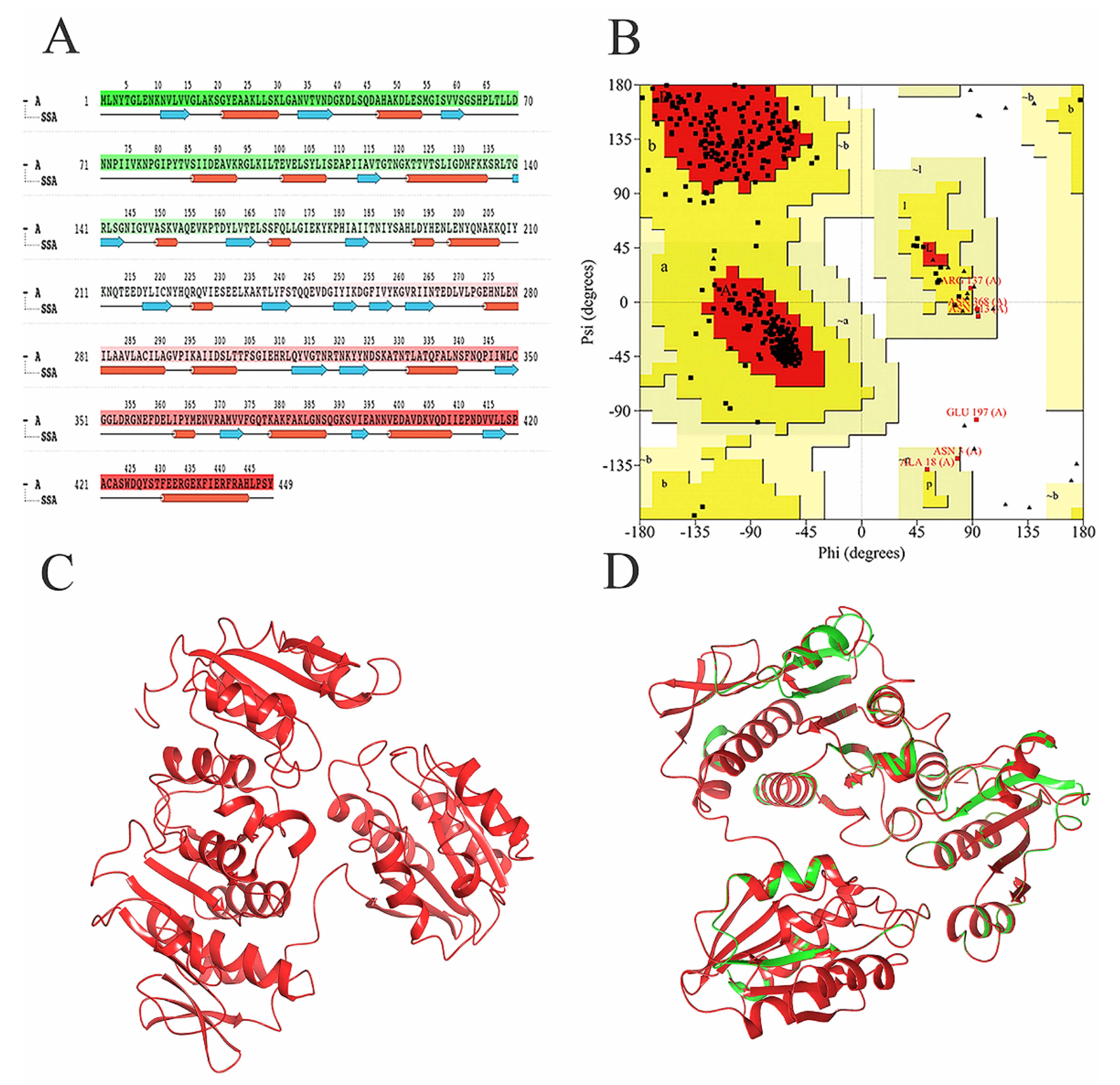
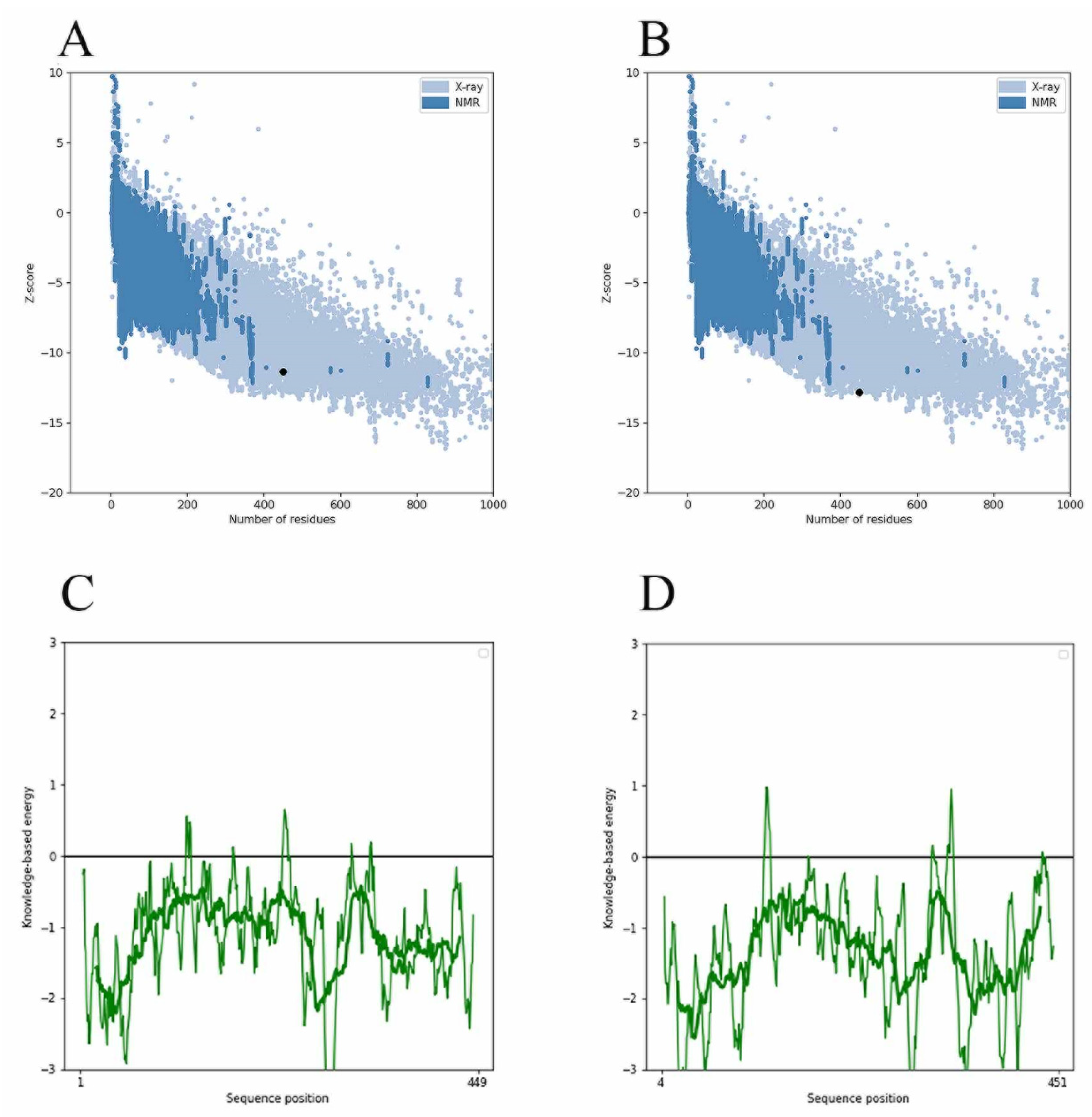
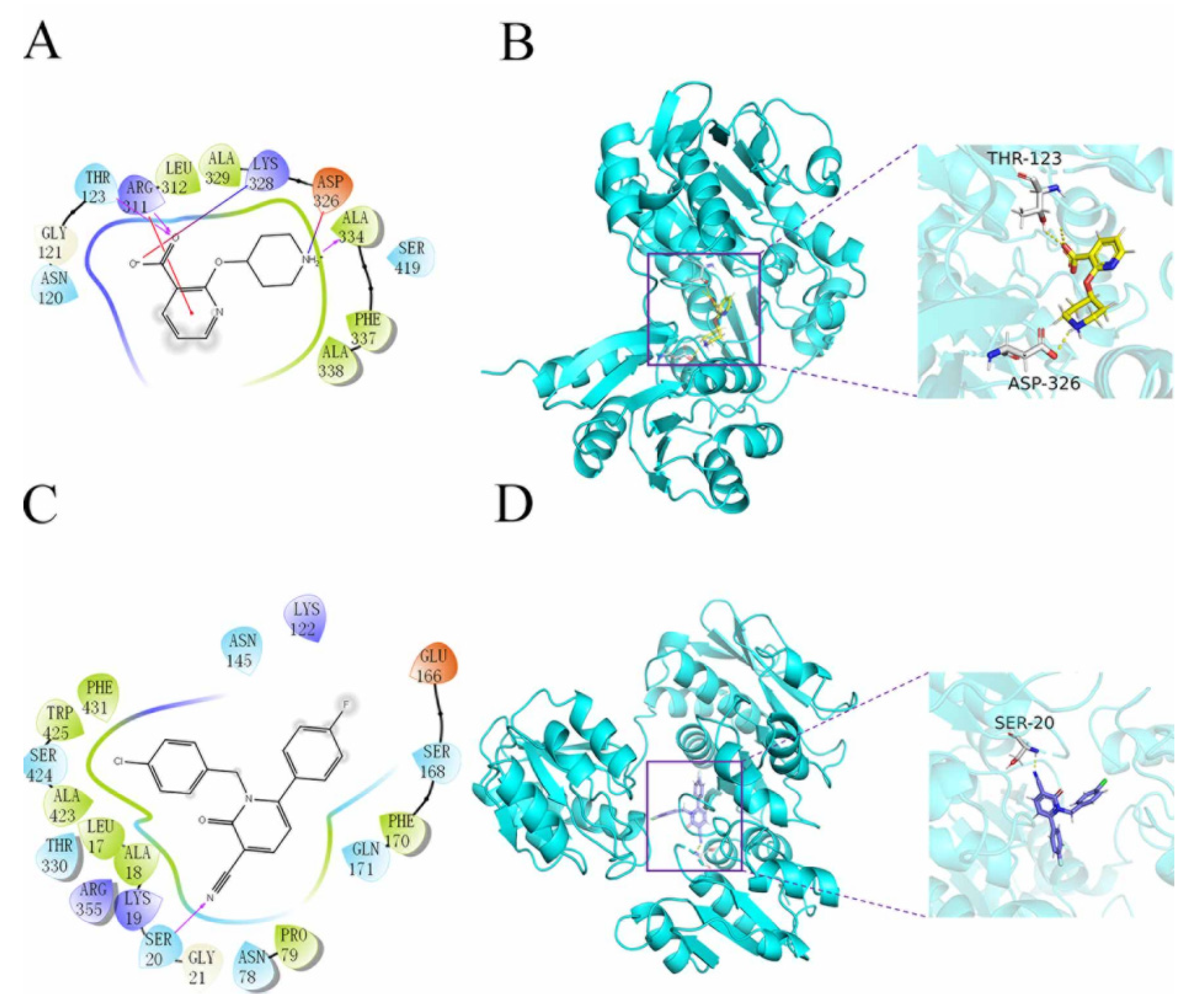
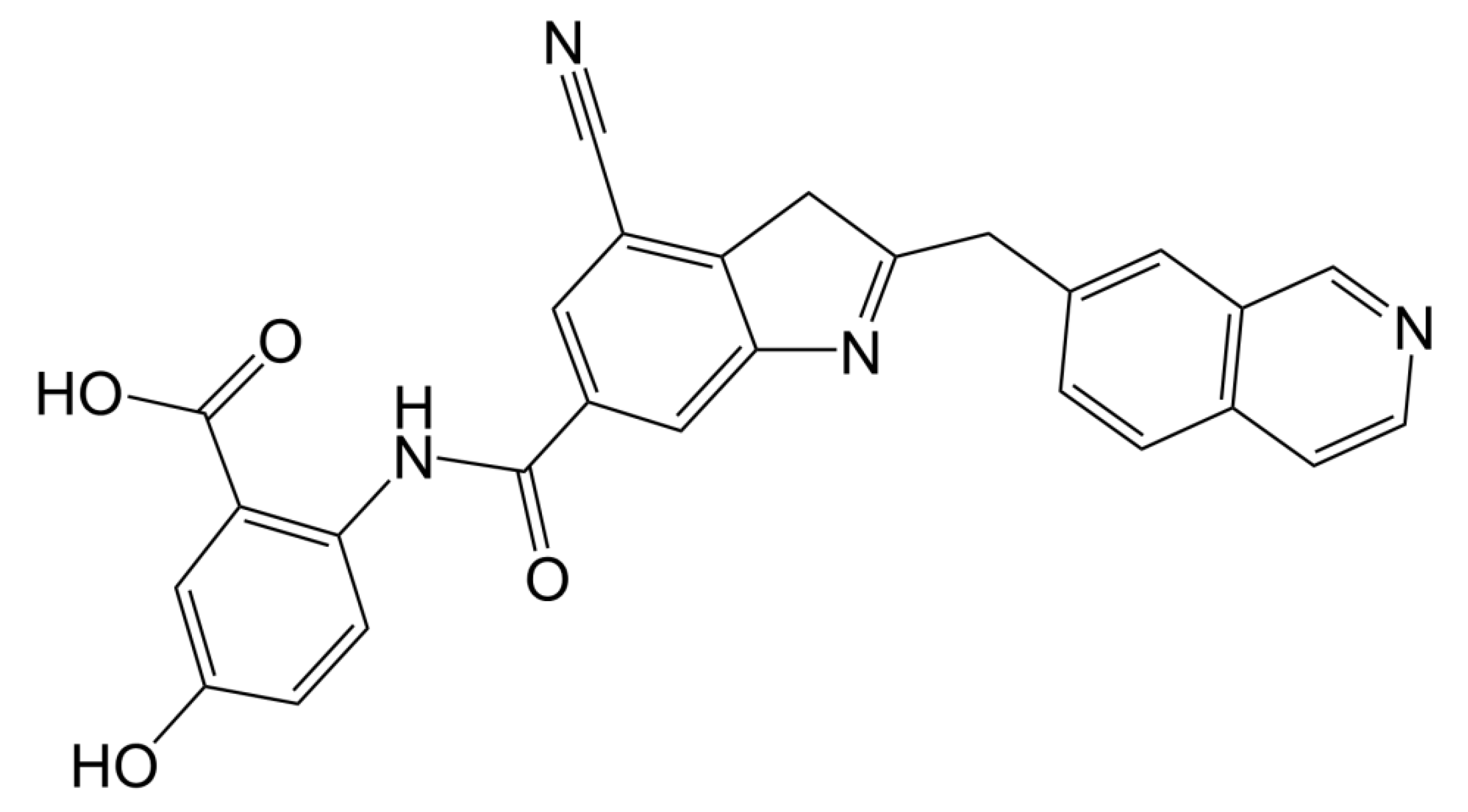
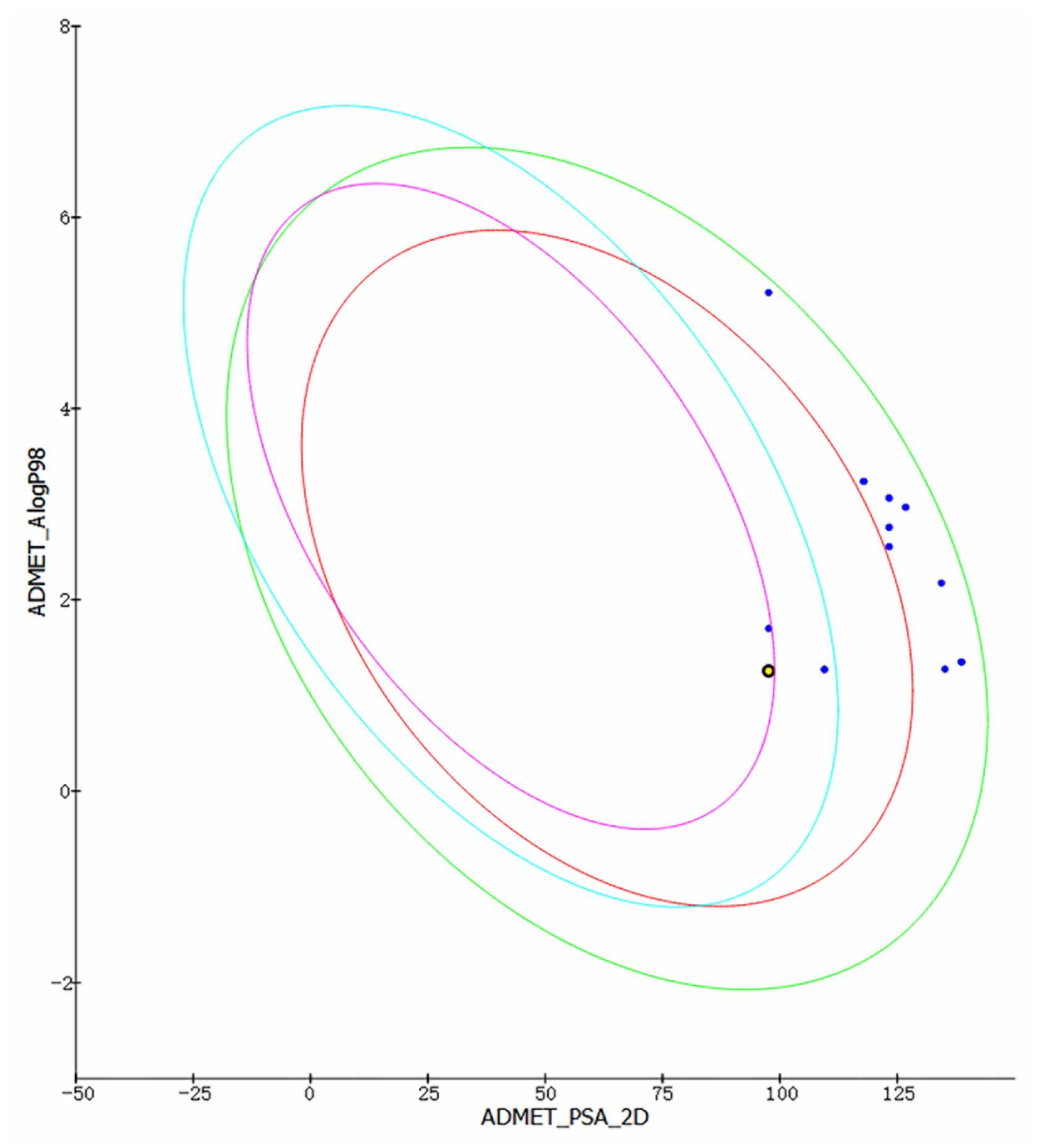
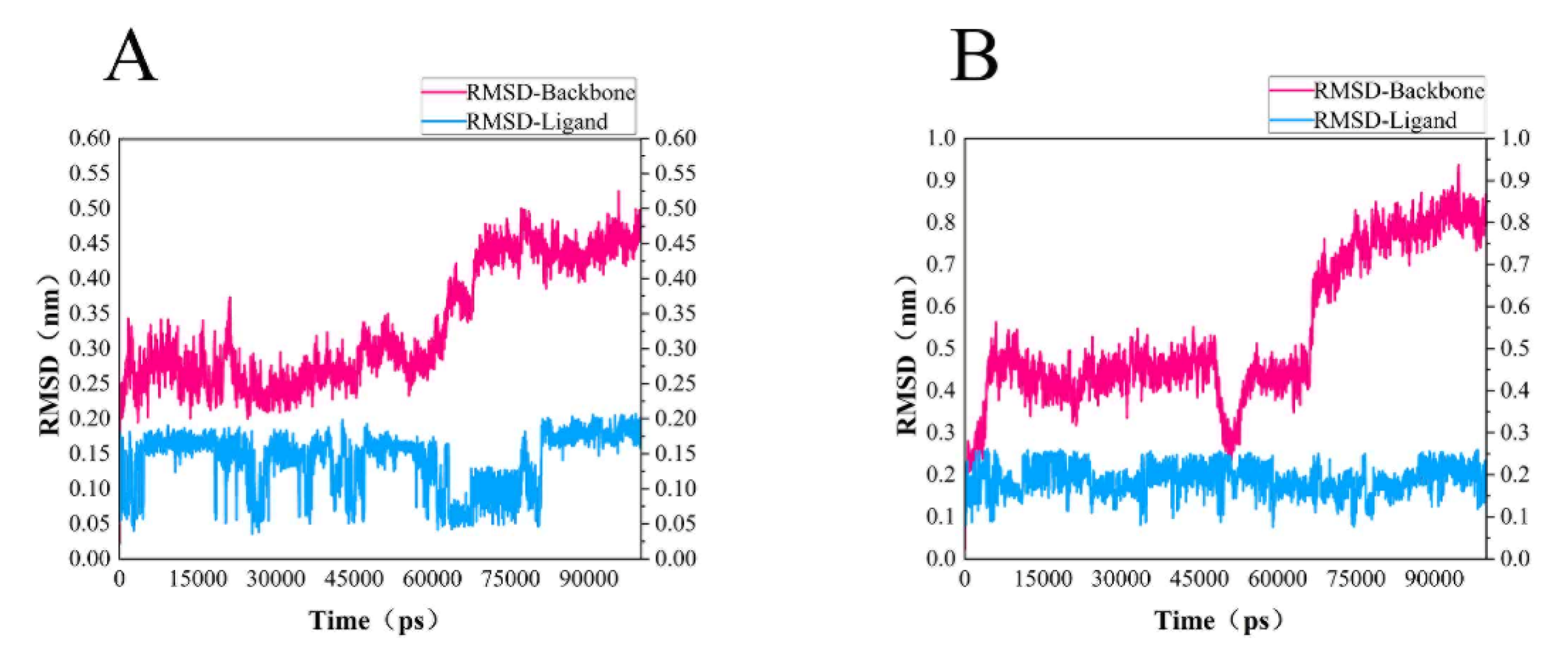
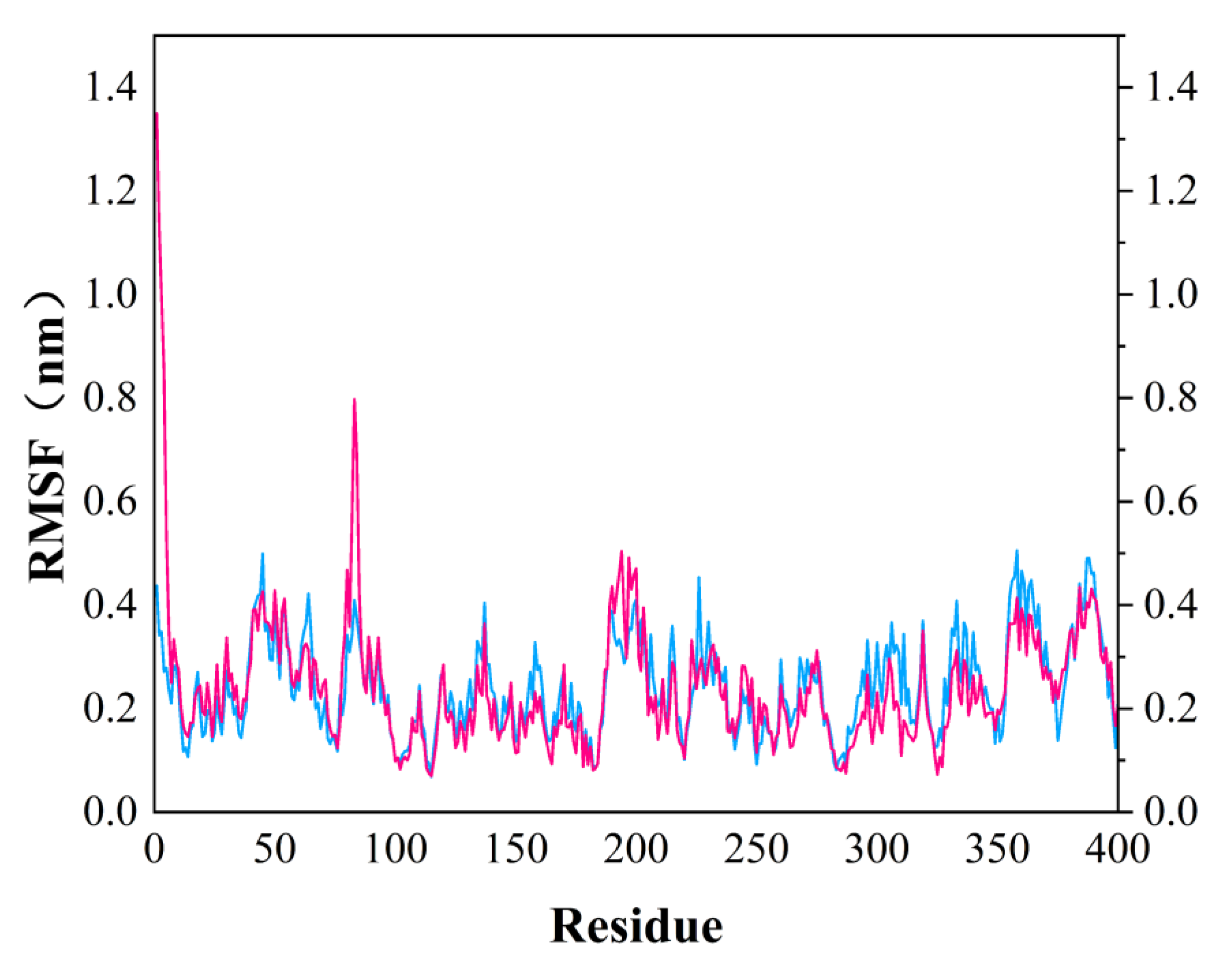
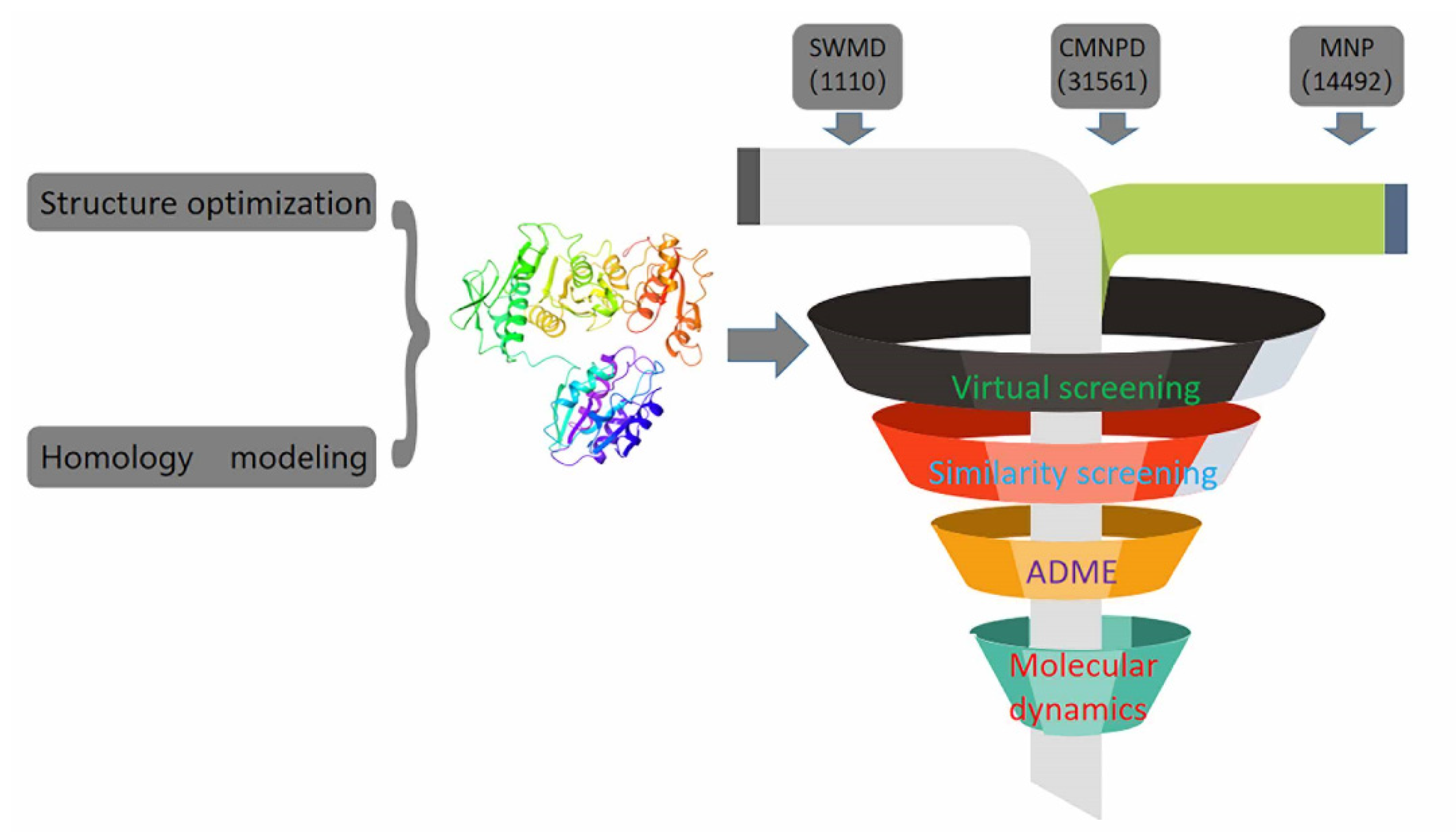


| Site Score | Size | D Score | Volume-1 | |
|---|---|---|---|---|
| Site 1 | 1.007 | 379 | 1.033 | 1125.04 |
| Site 2 | 0.607 | 34 | 0.57 | 82.663 |
| Site 3 | 0.817 | 35 | 0.795 | 106.673 |
| Site 4 | 0.644 | 31 | 0.545 | 54.194 |
| Site 5 | 0.625 | 31 | 0.507 | 102.9 |
| Ligand Name | ADMET Solubility | ADMET PPB Prediction | ADMET AlogP98 | ADMET BBB Level | PSA (TPSA) | ||
|---|---|---|---|---|---|---|---|
| CMNPD46604 | −2.045 | TRUE | 1.255 | 3 | 107.572 | ||
| CMNPD47366 | −3.783 | FALSE | 2.758 | 4 | 151.503 | ||
| CMNPD47366 | −3.783 | FALSE | 2.758 | 4 | 151.502 | ||
| CMNPD46608 | −2.728 | TRUE | 1.699 | 3 | 106.016 | ||
| CMNPD45974 | −2.188 | FALSE | 1.348 | 4 | 154.095 | ||
| CMNPD45974 | −2.188 | FALSE | 1.348 | 4 | 154.095 | ||
| CMNPD45975 | −2.188 | FALSE | 1.348 | 4 | 154.095 | ||
| CMNPD47365 | −3.575 | FALSE | 2.555 | 4 | 152.508 | ||
| CMNPD47365 | −3.575 | FALSE | 2.555 | 4 | 152.508 | ||
| CMNPD45454 | −2.568 | FALSE | 1.274 | 4 | 139.005 | ||
| MNP45266 | −3.689 | FALSE | 2.175 | 4 | 143.298 | ||
| CMNPD45751 | −4.24 | FALSE | 2.967 | 4 | 136.032 | ||
| CMNPD45751 | −4.24 | FALSE | 2.967 | 4 | 136.032 | ||
| CMNPD46650 | −6.014 | TRUE | 5.213 | 4 | 103.449 | ||
| CMNPD47369 | −3.805 | FALSE | 3.238 | 4 | 132.719 | ||
| CMNPD47369 | −3.805 | FALSE | 3.238 | 4 | 132.719 | ||
| CMNPD45909 | −3.886 | TRUE | 3.064 | 4 | 136.694 | ||
| CMNPD45909 | −3.886 | TRUE | 3.064 | 4 | 136.695 | ||
| CMNPD46636 | −2.01 | FALSE | 1.271 | 3 | 119.621 | ||
| CMNPD46636 | −2.01 | FALSE | 1.271 | 3 | 119.621 | ||
| Ligand Name | QPlogHERG | QPPCaco | QPlogPo/w | QPlogS | QPlogBB | QPPMDCK | |
| CMNPD46604 | −4.273 | 168.758 | 1.381 | −2.909 | −1.437 | 136.275 | |
| CMNPD47366 | −5.068 | 28.621 | 1.761 | −4.33 | −2.444 | 10.622 | |
| CMNPD47366 | −5.068 | 28.621 | 1.761 | −4.33 | −2.444 | 10.622 | |
| CMNPD46608 | −4.456 | 220.112 | 2.006 | −3.79 | −1.125 | 467.037 | |
| CMNPD45974 | −4.746 | 19.824 | 0.444 | −2.618 | −2.594 | 7.142 | |
| CMNPD45974 | −4.746 | 19.824 | 0.444 | −2.618 | −2.594 | 7.142 | |
| CMNPD45975 | −4.746 | 19.824 | 0.444 | −2.618 | −2.594 | 7.142 | |
| CMNPD47365 | −5.199 | 24.908 | 1.721 | −4.41 | −2.547 | 9.141 | |
| CMNPD47365 | −5.199 | 24.908 | 1.721 | −4.41 | −2.547 | 9.141 | |
| CMNPD45454 | −2.816 | 17.822 | 3.132 | −4.241 | −2.004 | 8.096 | |
| MNP45266 | −6.22 | 24.646 | 0.813 | −4.687 | −2.652 | 9.037 | |
| CMNPD45751 | −4.554 | 67.348 | 1.62 | −4.024 | −1.775 | 26.786 | |
| CMNPD45751 | −4.554 | 67.348 | 1.62 | −4.024 | −1.775 | 26.786 | |
| CMNPD46650 | −5.264 | 176.595 | 2.775 | −4.51 | −1.445 | 75.932 | |
| CMNPD47369 | −4.592 | 48.868 | 1.963 | −3.765 | −2.029 | 18.938 | |
| CMNPD47369 | −4.592 | 48.868 | 1.963 | −3.765 | −2.029 | 18.938 | |
| CMNPD45909 | −3.207 | 14.983 | 3.405 | −5.11 | −2.18 | 6.712 | |
| CMNPD45909 | −3.206 | 14.988 | 3.404 | −5.109 | −2.18 | 6.714 | |
| CMNPD46636 | −4.622 | 66.658 | 0.418 | −2.415 | −1.852 | 26.49 | |
| CMNPD46636 | −4.622 | 66.658 | 0.418 | −2.415 | −1.852 | 26.49 | |
| Molecular ID | Docking Score |
|---|---|
| CMNPD46604 | −6.035 |
| CMNPD46608 | −6.243 |
| D1 | −4.900 |
| N-({6-[(4-CYANO-2-FLUOROBENZYL)OXY]NAPHTHALEN-2-YL}SULFONYL)-d-GLUTAMIC ACID | −8.048 |
| N-[(6-butoxynaphthalen-2-yl)sulfonyl]-l-glutamic acid | −5.200 |
| N-[(6-butoxynaphthalen-2-yl)sulfonyl]-d-glutamic acid | −5.200 |
| Lysine Nz-Carboxylic Acid | −4.684 |
| Ligands Name | MM-GBSA dG Bind | MM-GBSA dG Bind vdW |
|---|---|---|
| MNP45266 | −59.25 | −34.14 |
| CMNPD45909 | −26.02 | −37.93 |
| CMNPD45974 | −29.93 | −30.38 |
| CMNPD147369 | −35.93 | −35.92 |
| CMNPD47369 | −37.87 | −35.44 |
| CMNPD45909 | −29.36 | −26.17 |
| CMNPD45974 | −33.15 | −26.04 |
| CMNPD45751 | −29.19 | −23.93 |
| CMNPD45454 | −23.86 | −31.44 |
| CMNPD46608 | −32.48 | −21.88 |
| CMNPD47366 | −34.05 | −38.77 |
| CMNPD47366 | −34.7 | −39.54 |
| CMNPD46604 | −33.74 | −30.06 |
| CMNPD47365 | −34.52 | −34.25 |
| CMNPD47365 | −32.5 | −38.65 |
| CMNPD46636 | −33.39 | −20.8 |
| CMNPD46636 | −34.15 | −22.94 |
| CMNPD46650 | −51.3 | −29.79 |
| CMNPD45975 | −32.27 | −30.34 |
| CMNPD45751 | −26.97 | −31.21 |
Publisher’s Note: MDPI stays neutral with regard to jurisdictional claims in published maps and institutional affiliations. |
© 2021 by the authors. Licensee MDPI, Basel, Switzerland. This article is an open access article distributed under the terms and conditions of the Creative Commons Attribution (CC BY) license (https://creativecommons.org/licenses/by/4.0/).
Share and Cite
Zheng, X.; Zheng, T.; Liao, Y.; Luo, L. Identification of Potential Inhibitors of MurD Enzyme of Staphylococcus aureus from a Marine Natural Product Library. Molecules 2021, 26, 6426. https://doi.org/10.3390/molecules26216426
Zheng X, Zheng T, Liao Y, Luo L. Identification of Potential Inhibitors of MurD Enzyme of Staphylococcus aureus from a Marine Natural Product Library. Molecules. 2021; 26(21):6426. https://doi.org/10.3390/molecules26216426
Chicago/Turabian StyleZheng, Xiaoqi, Tongyu Zheng, Yinglin Liao, and Lianxiang Luo. 2021. "Identification of Potential Inhibitors of MurD Enzyme of Staphylococcus aureus from a Marine Natural Product Library" Molecules 26, no. 21: 6426. https://doi.org/10.3390/molecules26216426
APA StyleZheng, X., Zheng, T., Liao, Y., & Luo, L. (2021). Identification of Potential Inhibitors of MurD Enzyme of Staphylococcus aureus from a Marine Natural Product Library. Molecules, 26(21), 6426. https://doi.org/10.3390/molecules26216426







